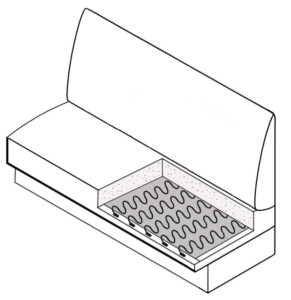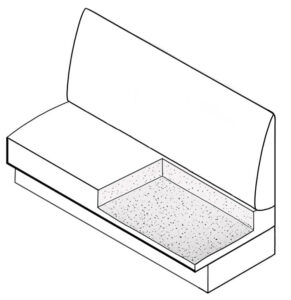When it comes to outfitting your restaurant with booth seating, the choice between springs or solid foam booth seat material is a crucial decision. Your customers spend a significant amount of time sitting in your booths, and comfort is key to creating a positive dining experience. But which booth seat construction is the best? Let’s break down the pros and cons of each option to help you decide.
The Importance of Booth Seat Cushions
The most important part of a restaurant booth is arguably the booth seat cushion, at least from a customer’s perspective. A well-made cushion provides comfort, support, and durability, ensuring your patrons enjoy their meals without discomfort.
There are two primary types of booth seat cushions:
- Spring-Based Booth Seats – These feature interlocking metal springs with a layer of foam on top.
- Solid Foam Booth Seats – These are made from a single, dense piece of foam.
Each option has its benefits and drawbacks, and much of the choice comes down to individual preference. Let’s take a closer look.

Spring-Based Booth Seats: Nostalgic Comfort with Added Maintenance
Spring seats are a classic choice, evoking the memory of vintage diners with shiny red vinyl booths and a soft, bouncy cushion. Many restaurant owners love spring-based booth seats for their nostalgic appeal, as they offer a distinctive “give” that some patrons find more attracting.
Advantages of Spring-Based Seats:
✅ A Nostalgic Experience – Springs create a slight bounce, making seating feel more traditional and retro, which can enhance the ambiance of a classic-style eatery.
✅ Weight Distribution – Metal springs help evenly distribute weight, ensuring consistent support across the booth seat cushion, seating two or more guests.
Disadvantages of Spring-Based Seats:
❌ Higher Maintenance Costs – If springs break, they are costly to repair, often requiring complete reupholstery.
❌ Durability Concerns – Sinuous springs, which are common in restaurant booths, are not hand-tied and can be prone to breaking or snapping over time. When this happens, certain areas of the seat may start to sag, leading to an uneven and uncomfortable seating experience.
❌ More Expensive to Manufacture – The construction of spring-based booths involves additional materials and labor, making them a pricier option upfront.

Solid Foam Booth Seats: Reliable, Supportive, and Cost-Effective
Solid foam booth seats have gained popularity in the last few years, due to advancements in high-resiliency foam technology. Many people associate foam with cheap, low-quality seating, but that’s only true if inferior foam materials are used. High-quality foam can last just as long – if not longer – than spring-based seating.
Advantages of Solid Foam Booth Seats:
✅ Firm and Supportive – Foam provides a structured and supportive seating experience, making it a reliable option.
✅ More Durable Over Time – Unlike springs, foam won’t snap or sag in isolated spots. Over time, all foam softens slightly, but commercial-grade high-resiliency foam is designed to hold up under heavy use.
✅ Lower Maintenance Costs – Foam seats don’t require metal components that could break, meaning they generally last longer with less maintenance.
✅ Cost-Effective – Solid foam is more affordable to manufacture than spring-based seating, making it an attractive option for restaurant owners looking to manage costs.
✅ Customizable Firmness – Foam comes in different densities, allowing for customization. Commercial-grade foam is typically firmer to ensure longevity, but over time, it softens slightly for added comfort.
Disadvantages of Solid Foam Booth Seats:
❌ Loss of Firmness Over Time – While foam is durable, it will eventually lose some of its original firmness and need replacement. However, this happens gradually and can take years in a high-quality booth.
❌ Different Feel Compared to Springs – Foam does not have the same bouncy effect as spring seats. Instead of a quick rebound, it offers more of a slow sink-in feel. Some customers may prefer the more traditional spring feel.
Choosing the Best Booth Cushions for Your Restaurant
When deciding between springs or solid foam booth seat material, consider the needs of your establishment and the preferences of your clientele.
- If you run a retro diner or a restaurant where nostalgia is key, spring-based seating might be the better choice to enhance that classic atmosphere.
- If you prioritize durability, low maintenance, and cost-effectiveness, solid foam booth seats are a smart investment.
Ultimately, both booth seat cushion options can be comfortable and stylish, but foam tends to be the more practical and long-lasting choice for most commercial settings.
Regardless of your choice, investing in high-quality materials ensures that your restaurant booths maintain their appearance, provide superior comfort, and withstand the daily wear and tear of a bustling dining environment.
Need help selecting the right seating for your restaurant? Contact us today to learn more about our premium restaurant booths!
